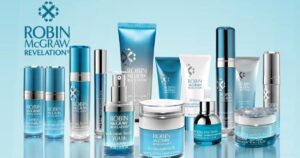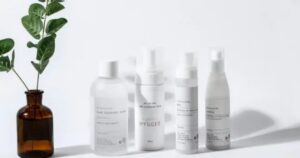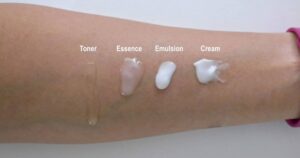The secret to achieving radiant and healthy skin lies in the meticulous order of skin care. By following a well-crafted routine, you can unlock the full potential of your skin’s natural beauty. Cleansing, toning, exfoliating, serum application, moisturizing, eye cream, and topping it off with sunscreen are the crucial steps that await you on this transformative journey. In this article, we will delve into the precise order of skin care, empowering you with the knowledge to create a flawless canvas for your daily routine.
Key Takeaways
- Cleansing and toning are essential steps in order of skincare, as they remove impurities, balance pH levels, and improve complexion.
- Exfoliating promotes smoother skin texture, unclogs pores, and prevents breakouts.
- Serum delivers concentrated active ingredients deep into the skin, reducing fine lines and improving skin texture.
- Moisturizing and using sunscreen are crucial for maintaining skin hydration, preventing dryness, and protecting against sun damage.
Cleansing For Order Of Skin Care
Cleansing is an essential step in any skin care routine as it helps to remove impurities and excess oil from the skin. One of the benefits of double cleansing is that it ensures a thorough removal of all dirt, makeup, and pollutants that may have accumulated on the skin throughout the day. The first step involves using an oil-based cleanser to break down and remove makeup and sunscreen, while the second step uses a water-based cleanser to deeply cleanse the skin. It is important to choose the right cleanser for your skin type and concerns. For example, those with oily or acne-prone skin may benefit from a cleanser containing salicylic acid to help unclog pores. Cleansing prepares the skin for the next step in the skincare routine, which is toning.
Toning
Applying a toner after cleansing helps to balance the skin’s pH levels and tighten pores, creating a smoother and more refined complexion. Toning is an essential step in any skincare routine as it provides numerous benefits. Firstly, toners help to remove any remaining impurities or traces of cleanser from the skin, ensuring a thorough cleanse. Secondly, toners help to restore the skin’s natural pH balance, which can be disrupted by harsh cleansers. This rebalancing effect helps to improve the skin’s overall health and appearance. Additionally, toners can help to hydrate and nourish the skin, as many toners contain ingredients like hyaluronic acid and antioxidants. When it comes to toning techniques, there are various options available, including using a cotton pad, spraying directly onto the face, or patting the toner into the skin with your hands. Experimenting with different techniques can help you find the one that works best for you.
| Toning Benefits | Toning Techniques |
|---|---|
| Balances pH levels | Use a cotton pad |
| Tightens pores | Spray directly onto face |
| Removes remaining impurities | Pat into skin with hands |
| Hydrates and nourishes the skin | |
| Improves overall complexion |
Exfoliating
Regular exfoliating, at least twice a week, helps to slough off dead skin cells and promote a brighter, smoother complexion. Exfoliating is an essential step in any skincare routine, offering a multitude of benefits for the skin. Here are some key benefits of exfoliating:
- Removes dead skin cells: Exfoliating helps to unclog pores and remove the build-up of dead skin cells, allowing for better absorption of skincare products.
- Improves skin texture: By removing the top layer of dead skin cells, exfoliating promotes a smoother and softer skin texture.
- Enhances skin radiance: Exfoliating stimulates cell turnover, revealing a fresh layer of skin that appears more radiant and glowing.
- Prevents breakouts: Regular exfoliation can help prevent clogged pores and reduce the occurrence of acne breakouts.
In order Of Skin Care to achieve the best results, it is important to choose the right exfoliating techniques for your skin type. Now, let’s move on to the next step in the skincare routine: serum.
Serum
Serum is a lightweight, highly concentrated skincare product that is designed to deliver active ingredients deep into the skin. It offers numerous benefits and uses, such as reducing fine lines and wrinkles, brightening the complexion, and improving skin texture. When applying serum, it is important to use a small amount and gently pat it onto the skin, allowing it to fully absorb before applying other products. Choosing the right serum for your specific skin concerns is crucial for achieving the desired results.
Serum Benefits and Uses
The efficacy of using serums can be attributed to their high concentration of active ingredients. Serums are skincare products that are designed to deliver potent doses of active ingredients directly into the skin. They are formulated with a variety of ingredients, each targeting specific skin concerns. Some common serum types include:
- Hyaluronic Acid Serum: Helps to hydrate and plump the skin, reducing the appearance of fine lines and wrinkles.
- Vitamin C Serum: Brightens the complexion, evens out skin tone, and protects against free radicals.
- Retinol Serum: Stimulates collagen production, improves skin texture, and reduces the signs of aging.
- Niacinamide Serum: Regulates oil production, reduces redness, and minimizes the appearance of pores.
When it comes to serum ingredients, they can vary widely depending on the specific product. However, some common ingredients found in serums include antioxidants, peptides, hyaluronic acid, vitamins, and plant extracts. These ingredients work together to target specific skin concerns and provide visible results.
Proper Serum Application
Two key steps for optimal results: Apply a small amount of serum, then gently massage it into the skin using upward motions. Proper serum application techniques can greatly enhance the effectiveness of your skincare routine. When applying serum, it is important to use the right amount and to massage it into the skin in the correct way. This helps the serum penetrate deeper into the skin and allows for better absorption of its beneficial ingredients.
In order of skin care to understand the importance of proper serum application, let’s take a look at some common serum ingredients and their benefits:
| Serum Ingredient | Benefits |
|---|---|
| Hyaluronic Acid | Hydrates and plumps the skin, reducing the appearance of fine lines and wrinkles. |
| Vitamin C | Brightens the skin, evens out skin tone, and boosts collagen production. |
| Retinol | Stimulates cell turnover, reduces the appearance of wrinkles, and improves skin texture. |
Choosing the Right Serum
When considering the effectiveness of a skincare routine, it is crucial to carefully select and apply a serum with the appropriate ingredients for optimal results. A serum acts as a powerhouse in any skincare regimen, delivering active ingredients deep into the skin to address specific concerns. Here are essential factors to consider when choosing the right serum:
- Serum Ingredients: Look for key ingredients like hyaluronic acid for hydration, vitamin C for brightening, retinol for anti-aging, and niacinamide for reducing redness and inflammation.
- Skin Type: Different skin types require different serums. For dry skin, opt for serums with moisturizing and nourishing ingredients. Oily skin can benefit from lightweight, oil-free serums. Combination skin may need a serum that balances oil production while providing hydration. Sensitive skin may require gentle, fragrance-free serums.
Moisturizing
Properly moisturizing the skin is essential for maintaining its hydration and preventing dryness and irritation. Hydrating the skin not only improves its appearance but also strengthens the skin barrier, which acts as a protective shield against environmental aggressors. To effectively moisturize the skin, it is important to understand the different types of moisturizers and their benefits. Here is a table summarizing the main types of moisturizers and their key characteristics:
| Moisturizer Type | Description |
|---|---|
| Creams | Thicker consistency, suitable for dry skin |
| Lotions | Lightweight texture, ideal for normal to combination skin |
| Gels | Cooling and refreshing, great for oily or acne-prone skin |
| Balms | Ultra-nourishing, perfect for severely dry or sensitive skin |
| Serums | Concentrated formulas, target specific skin concerns |
Eye Cream
Applying eye cream daily and gently massaging it into the delicate skin around the eyes can help reduce the appearance of fine lines and wrinkles. Eye cream is specifically formulated to address the unique needs of the eye area, which is prone to dryness and signs of aging. Here are some benefits of using eye cream:
- Hydration: Eye creams provide intense hydration to the thin and delicate skin around the eyes, helping to plump up the skin and diminish the appearance of fine lines.
- Dark circle reduction: Some eye creams contain ingredients like vitamin C or caffeine that can help reduce the appearance of dark circles and brighten the under-eye area.
- Puffiness reduction: Certain eye creams contain ingredients like retinol or peptides that can help reduce puffiness and inflammation.
- Prevention of future damage: Eye creams often contain antioxidants and SPF to protect the delicate skin from environmental damage and prevent premature aging.
When choosing an eye cream, look for ones that are suitable for your skin type and address your specific concerns, such as dryness, wrinkles, or dark circles. Some popular options include retinol-based creams, hydrating formulas, or those with natural ingredients like chamomile or green tea extract. It’s best to consult with a dermatologist or skincare professional to find the best eye cream for your needs.
Sunscreen
The efficacy of sunscreen in protecting the skin from harmful UV rays is crucial for preventing sunburn and reducing the risk of long-term damage. Sunscreen works by absorbing or reflecting the UV radiation, acting as a barrier between the skin and the sun. However, it is important to note that not all sunscreens are created equal. Different skin types require different types of sunscreen for optimal protection. Here is a table outlining the recommended sunscreen options for different skin types:
| Skin Type | Recommended Sunscreen |
|---|---|
| Normal | Broad-spectrum SPF 30 or higher |
| Oily | Oil-free, non-comedogenic SPF 30 |
| Dry | Moisturizing SPF 30 or higher |
| Sensitive | Physical sunscreen with zinc oxide |
| Combination | Lightweight, non-greasy SPF 30 |
Choosing the right sunscreen for your skin type ensures that you can enjoy the sun while minimizing the risk of sunburn and long-term damage. Remember to apply sunscreen generously and reapply every two hours for maximum protection.
Frequently Asked Questions
How Often Should I Cleanse My Skin?
Cleansing your skin is a vital step in any skincare routine. The frequency of cleansing depends on various factors like skin type, environmental factors, and personal preference. Double cleansing can provide additional benefits by thoroughly removing impurities and improving overall skin health.
Can I Exfoliate My Skin Every Day?
Exfoliating frequency should be determined by skin type and sensitivity. While daily exfoliation may be suitable for some, it is generally recommended to exfoliate 2-3 times per week to reap the benefits of smoother texture, improved skin tone, and unclogged pores.
Is It Necessary to Use Both a Serum and a Moisturizer?
Both a serum and a moisturizer serve different purposes in a skincare routine. While a serum targets specific concerns such as wrinkles or dark spots, a moisturizer hydrates and protects the skin. Using both can provide optimal benefits for overall skin health and appearance.
Should I Apply Eye Cream Before or After Moisturizing?
When considering the order of skin care, it is essential to address the question of when to apply eye cream. To maximize its efficacy, it is generally recommended to apply eye cream before moisturizing, allowing it to penetrate the skin more effectively.
Can I Skip Sunscreen if I’m Using a Moisturizer With Spf?
While using a moisturizer with SPF can provide some sun protection, it is not a substitute for sunscreen. Sunscreen offers broad-spectrum protection against harmful UV rays, preventing skin damage and reducing the risk of skin cancer.
Conclusion
In conclusion, following a proper order of skin care routine is essential for maintaining healthy and radiant skin. The order of skin care typically includes cleansing, toning, exfoliating, applying serum, moisturizing, and protecting the skin with sunscreen. One interesting statistic reveals that according to a survey, nearly 70% of people who consistently follow a skincare routine reported a noticeable improvement in their skin’s appearance and overall health. Therefore, adhering to this order of skin care can greatly benefit individuals in achieving optimal skin health.









